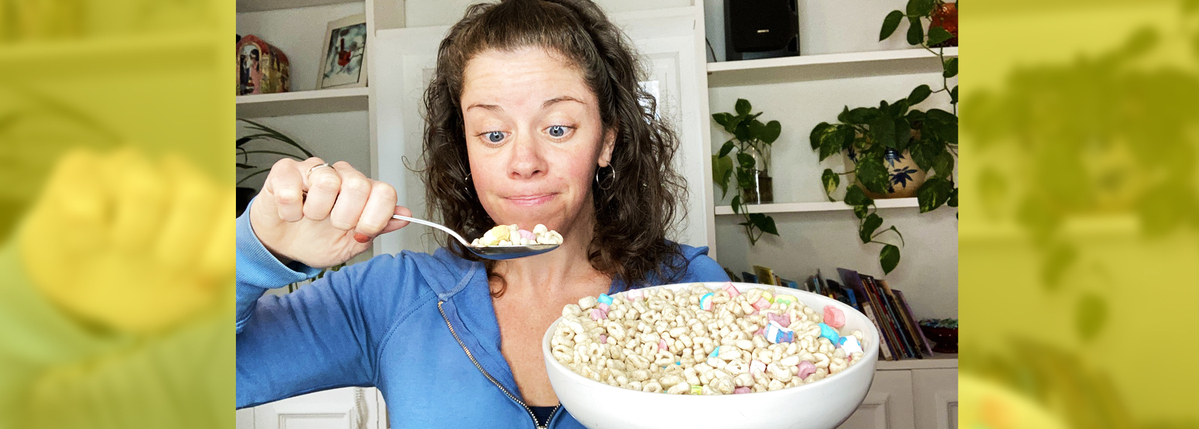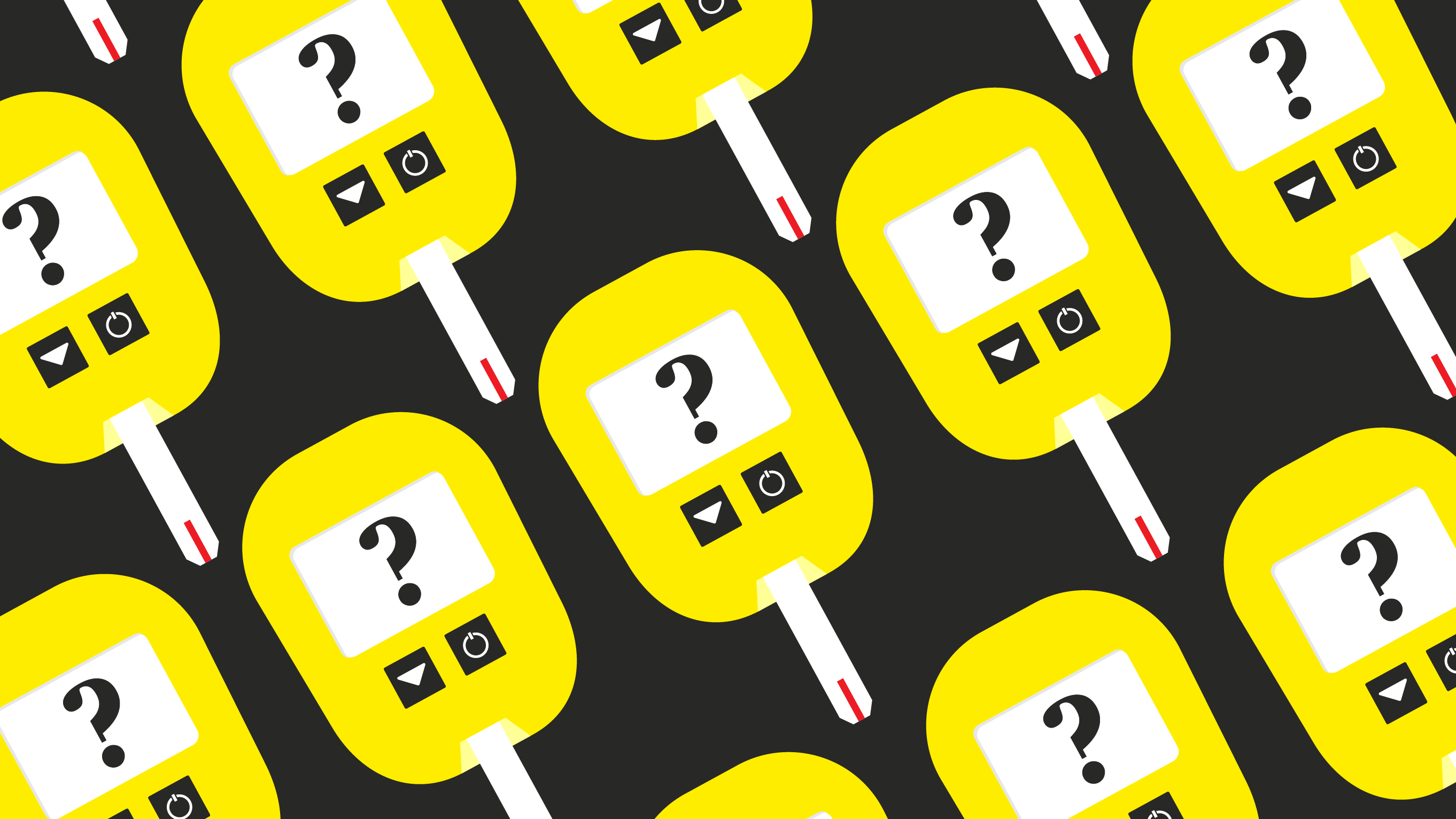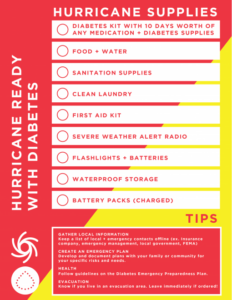Diabetes Disaster Preparedness Plan
Written by: Beyond Type 1 Editorial Team
7 minute read
August 24, 2018
Managing diabetes can be even harder when you are dealing with a major storm, loss of electricity and possible evacuation from your home. Building a “diabetes kit” now can save a lot of worry and time when a disaster strikes. A checklist template is included for your use.
Note: Beyond Type 1 is proud to be a part of the Diabetes Disaster Response Coalition, alongside American Diabetes Association, Insulin for Life USA, JDRF, the American Association for clinical endocrinologists, the American Association for Diabetes Educators, Endocrine Society, The Leona M. and Harry B. Helmsley Charitable Trust, Lilly, Insulet and T1D Exchange, among others. This content is from the Diabetes Disaster Response Coalition.
This article was last updated Tuesday, May 18, 2021.
Do you or your loved one have diabetes and use insulin?
Make a plan to stay healthy during natural disasters or emergencies. Managing diabetes can be even harder when you are dealing with a major storm, loss of electricity, wildfire and possible evacuation from your home. Building a “diabetes kit” now can save a lot of worry and time when a disaster strikes. A checklist template is included for your use.
Your diabetes kit can be stored in an easy-to-carry waterproof bag or container to hold the documents, information and supplies that you will want to have with you.
Important information to keep in your kit:
- Type of diabetes you have, medical conditions, allergies and previous surgeries
- Current medications, doses and time you take them. Include your pharmacy name, address and phone number
- Previous diabetes medications you have taken
- Letter from your diabetes care team with a list of your most recent diabetes medications, if possible
- A copy of your most recent laboratory result, like A1C results
- Make, model, and the serial number of your insulin pump or continuous glucose monitor (CGM). Include the pump manufacturer’s phone number in case you need to replace your device.
- Doctor’s name, phone number and address
- Phone numbers and email addresses for your family, friends and work (include out-of-town contacts)
- A copy of your health insurance card
- A copy of your photo ID
- Cash
Diabetes supplies
- Additional week supply (or more) of all medications, including insulin and Glucagon, if prescribed. If you lose power and you have unused insulin, don’t throw it out!
- In an emergency, it is okay to use expired or non-refrigerated insulin
- Protect your insulin pump from water.
- Supplies to check your blood sugar, like testing strips and lancets. Don’t forget extra batteries!
- Extra supplies for insulin pump or CGM
- Cooler and reusable cold packs. Note: Do NOT use dry ice and do not freeze the medication.
- Empty plastic bottle or sharps container to safely carry syringes, needles and lancets
- Items to treat high blood sugar such as pump supplies (infusion sets) and/or syringes
- Items to treat low blood sugar (hypoglycemia), like:
- Juice
- Regular soda
- Honey
- Glucose tablets
- Glucagon:
- Nasal glucagon – Baqsimi®: This is an emergency glucagon that’s administered through your nose.
- Glucagon pen – Gvoke HypoPen®: This is a premixed glucagon injection that you press against your thigh. The auto-inject device makes it quick and easy to use. It is also available in a prefilled syringe (PFS).
- Glucagon vial & syringe – Gvoke Kit®: This is a premixed glucagon in a vial that comes with a syringe, allowing you to draw up the dose manually and inject it directly into your thigh.
- Glucagon pen – Zegalogue®: Also a premixed glucagon, available as an easy-to-use auto-inject device. It is also available in a prefilled syringe (PFS).
- Learn about copay cards and patient assistance programs to get glucagon.
A note on stocking up on prescriptions before or during an emergency situation:
- Contact your physician and make sure all your prescriptions are current and have a maximal number of refills available. Consider backup medications, like having long-acting insulin on hand if you are a pump user.
- Call your insurance company and find out if you can enroll to receive 90-day prescription refills via mail-order shipments.
- If a state of emergency has been declared, you may be able to refill a prescription even it is before the typical 30-day time window. If your state is currently experiencing an emergency, call your pharmacy to find out if your state and/or health insurance company has waived refill restrictions.
Other supplies to pack
- In light of the COVID-19 pandemic, it’s highly recommended to have on hand face masks, disinfectant wipes and hand sanitizer
- If you have been vaccinated, don’t forget to include your vaccination card; if you have not been vaccinated, we strongly encourage you to do it as soon as possible.
- Two-day supply of non-perishable ready-to-go food, like pre-packaged tuna, beans, cheese and cracker snacks, etc.
- Nuts or nut butter
- High-fiber/protein granola bars
- Dried fruits
- Anything according to dietary restrictions
- A three-day supply of bottled water (or more)
- Pen/pencil and notepad to record blood sugar, other test results and any new signs/symptoms
- First aid supplies like bandages, cotton swabs and antibiotic ointments or creams
- Extra clothing, including socks and undergarments
- Cell phone and charging supplies for phone and pump including battery pack
- Flashlight and batteries
Other recommendations
- Make sure that all your vaccinations are up-to-date.
- Choose a meeting place with your family in case you are separated. Write down the location and include it in your kit.
- Wear a medical ID or medical alert bracelet or other forms of identification in case you are evacuated to a relief shelter.
- For children, write down the name of the school, address and phone number.
Download the checklist (page 1, 2)
Additional phone numbers/websites that might be useful:
Customer care insulin manufacturers
- Lilly: 800-545-5979
- Sanofi-Aventis: 800-633-1610
- Novo Nordisk: 800-727-6500
Customer care insulin pump manufacturers
- Omnipod/Insulet: 800-591-3455
- Dexcom: 888-738-3646
- Medtronic: 800-633-8766
Health insurance
- Centers for Medicare and Medicaid Service—www.cms.hhs.gov.
- Insure Kids Now!—Every state in the nation has a health insurance program for people under 18. This website is offered by the US Health and Human Services Department—www.insurekidsnow.gov; 800-877-Kids-Now.
- National Drugstores and Pharmacy Chain Patient Assistance—Speak with your local pharmacist about their prescription programs. Stores with these programs include Costco, CVS, K-mart, Rite Aid, Target, Wal-Mart and others.
- NIDDK – Publication called “Financial Help for Diabetes Care” which offers programs, that may provide coverage for medical expenses for a person with diabetes. The publication can be viewed online at www.diabetes.niddk.nih.gov/dm/pubs/financialhelp/; 800-860-8747.
- Partnership for Prescription Assistance—Assistance program available to help offset the cost of supplies or prescription medicines 888-477-2669 or www.pparx.org.
- United Healthcare Children’s Foundation—The Foundation provides financial assistance toward the family’s share of the cost of medical services; www.uhccf.org.
Companies that donate supplies
- Aventis – Donates Lantus insulin; 800-221-4025.
- Becton, Dickinson and Company (BD) – Money saving coupons for syringes and patients just need to call and request coupons. The company also offers a one-time only coupon for a free box of syringes.
- Lifescan – contact for assistance with glucose monitor supplies at 800-227-8862 or send an email request with name and address to [email protected].
- BlinkHealth – https://www.blinkhealth.com/.
- Lilly Disaster Response—Donates insulin (basalglar, Glucagon, Trulicity, Humalog, Humulin and Mumalog Mix)—See the website for guidance on how to prepare for a disaster and how to replace missing or damaged insulin at no cost during a disaster. Additionally Lilly has prepared this guide for disaster relief.
- Novo Nordisk—A prescription savings program for Novolin R, N or 70/3010 ml vials to help uninsured patients or patients enrolled in a high deductible health plan at any pharmacy in the CVS Caremark retail net-work. You will pay $25 per vial after downloading a prescription savings card; https://www.reducedrx.com/.
- Novo Nordisk Patient Assistance Program (PAP)—Provides free medicine (to those who qualify) including: Levemir, Novolog, Novolog Mix 70/30, Novolin, GlucaGen Hype Kit, Victoza and disposable needles for FlexPens and Victoza. (Insulin is vial-only no pens); https://www.novocare.com/psp/PAP.html
- Sanofi Patient Connection Program—No insurance. Provides Apidra, Lantus, Soliqua 100/33 and Toujeoat no cost to patients who meet program eligibility requirements; http://www.sanofipatientconnection.com/patient-assistance-connection.
Additionally, drug companies that sell insulin or diabetes medications usually have patient assistance programs. Such programs are available only through a physician.
Other programs
Downloadable checklists
Sources
Adapted from American Association of Clinical Endocrinologists (AACE)—My Diabetes Emergency Plan. For additional emergency preparation resources for people with diabetes, visit: http://mydiabetesemergencyplan.com.
www.DiabetesDisasterResponse.org • Questions? Call 765-314-DDRC (765-314-3372)

Author
Beyond Type 1 Editorial Team
Beyond Type 1 is the largest diabetes org online, funding advocacy, education and cure research. Find industry news, inspirational stories and practical help. Join the 1M+ strong community and discover what it means to #LiveBeyond a diabetes diagnosis.
Related Resources

Editor’s note: This article does not substitute for medical advice from your healthcare team. Severe...
Read more

There’s a hill in my town that I have grown quite familiar with. When I...
Read more

Hyperglycemia—or high blood sugar—can sneak up on you, whether it’s from a missed dose, a...
Read more



